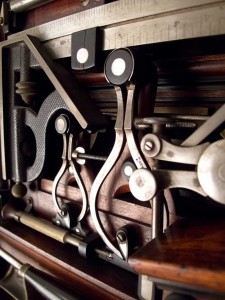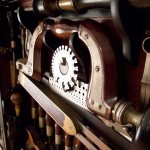We may receive a commission when you use our affiliate links. However, this does not impact our recommendations.
It takes a long time – months, really – to recover your senses after spending time with the tool chest of H.O. Studley.
During our first visit with the chest in 2011, we spent about an hour taking random shots of the thing, as if it might just disappear from the wall at any second. As a result of that first photography session with the chest, we filled up several hard drives with data – both stills, text and video.
But it wasn’t near enough.
This week, Don Williams, Narayan Nayar and I are at an undisclosed location in the Northern Hemisphere to spend three of four more days photographing and documenting the incredible chest of Mr. Studley.
This year, we managed to get our equipment set up quickly. We reviewed our notes from the last visit. And we made a plan while eating cheeseburgers. This blog entry is not about that plan.
Instead, it is about what has been germinating in my head during the 12 months I’ve spent away from the chest, occasionally digging through my photos and notes. I’ve tried to make a personal inventory of the questions I would like to answer this week as I handle every object in this iconic chest.
At the top of the list: Why is the chest arranged the way it is? The organization could be organic, deliberate or deliberately organic. The placement of the tools has mystified me to no end. Why would you put all of your chisels at the back of the chest? Removing a single chisel is akin to parallel parking an 18-wheeler in Manhattan.
Why are all the drill bits and augers (and there are dozens of them) packed behind layers of other tools? And on an on.
During our investigation this evening, Williams made an interesting observation: Many of the tools used for setting out were in the first layer of tools. Here are the setting out tools in the front layer of the chest:
• Five marking, cutting and mortise gauges.
• Three dividers.
• Three calipers.
• Combination square.
• Double square.
• Two rules.
• One scratch awl.
• One thickness gauge.
• Two folding rules.
Another question: Can I learn anything from the edges of the cutting tools and gauges? I plan to spend several hours looking at the business end of the chisels, the planes, the gauges and anything else that cuts wood.
There’s only one sharpening stone in the chest, but I have doubts that it was the only sharpening implement Studley used.
And my last goal: Making sure that every single bit of anything in that chest is inventoried, layer by layer. It’s a tall order. But I might not get another crack at it. So off to bed for me.
— Christopher Schwarz
Here are some supplies and tools we find essential in our everyday work around the shop. We may receive a commission from sales referred by our links; however, we have carefully selected these products for their usefulness and quality.















Chris: I found an Easter egg on this page which appears to my eye to be H.O. Studley’s workbench! If I’m right, I had no idea such a thing was out there. What can you tell us about this incredible edifice? The vice on that thing is one of the most amazing I have seen, and the paneling and drawers are beautifully executed too. Are the drawers compartmentalized as one might expect after seeing the tool cabinet? Are there tools the bench drawers as well?
Based on my shop experience, I’d venture that the drills and augers are in back because they’re infrequently used.
I’ve accumulated a full set of Fray/Spoffords (7″ – 17″) and have four sets of auger bits ( coarse and fine, Jennings and Irwin). Yet in day-to-day woodworking I’m suprised how often they’re untouched.
I would like to see a detail of the different layers and how he fit things together, for inspiration so that I can build something similar.
That beeping sound from the back of your car is not a lost pager. It is a small GPS tracking device so that I may discern the exact whereabouts of said chest….
Thank you for your hard work on this one. While my persistent nagging on the subject might not persuade you, the iconic status of this toolchest guarantees a very wide audience for this book. You may interperet that as a “cash cow”. Now it’s time to get milking.
That is one hell of a chest.
I noticed from one picture that the top and bottom are tails that fit into pins on the sides. Since the cabinet hangs on a wall, I am surprised that the top and bottom aren’t pins (like the front of a drawer) and the sides the tail pieces.
Chris,
One of the questions I have is: Do you find evidence of iterations? Was this the final grand tool chest, well planned out in advance, or did the tools and placement change over time as pieces were added to or (re)moved in the chest? Are there any clues about which tools were first acquired and stored and which ones he picked up over the years?
This is a huge project. While there will almost certainly be times of mind numbing tedium, I envy you.
Brent
Other than tool storage and display one function of a tool chest like that is to get instant respect from other workers and supervisors. It is like a large sign that says I know what I am doing so don’t screw with me. It is also an excellent way to be able to see if anything is missing at end of day.
Those few piano makers I know knew just what work they were going to do each day. At the start of the day, they removed those tools needed for the tasks and had them ready to hand at the bench. If another tool was needed, the worker just went to the tool chest to retrieve it.
I suspect that Studley, who worked in an organ and piano factory, knew what tools he needed for a particular job. Even more so, my guess is that the design of the chest was an exercise in how to fit as much into a small space, much as a piano or organ is an exercise in how to fit a ton of moving pieces into a given small space.
There are also many Masonic symbols worked into the chest along with the mensuration tools: the various pillars are examples of typical Masonic embellishments. I’m not an expert on that subject but I bet there are more features hidden away in there and some that only a Mason might be willing to explain.
Looking at some of the edges could be misleading. I’ve read that many of the tools currently in the chest were not Studely’s originals but replacments. The story is that supposedly a previous owner of the chest sold a number of the tools and a subsequent owner bought replacements to fill the chest.
Chris:
To answer your question: “Why is the chest arranged the way it is?,” I think you would need to use the chest for an extended period (probably not a viable option), just as you did and reported back about with various benches and other tool storage arrangements.
Building a replica and putting it through the paces is the way to go. Maybe there is genius in the H.O. Studley layout, or maybe it’s just visually appealing and a disaster to use. Maybe because it is not easy to use is why it has survived mostly intact – it was a show piece. Maybe Mr. Studley used other tools, all left randomly scattered about his shop buried under shavings and dust in various states of repair. Or, maybe he spent the first hour of the day reverently extracting and laying out his tools for work, and the last hour of the day wiping down and replacing the tools, all the while muttering incantations in a lost tongue.
Chris, Are you going to offer a DVD with all your images on it? I, for one, would love to be able to pore over the images and go through the chest layer by layer, tool by tool.
Dont Bogart your good fortune. Please Share!
Mike
Have you been able to determine the significance of having the Masonic Emblem,square and compasses/w the Letter G; in the bottom right corner of the one left panel shown? Quite an unusual an inclusion for a tool chest. Obviously he was a Mason; and proud of it. Are either tool removable and usable as working tools of the artist?
Thanks *very* much for the pictures.
That is definitely a kick-ass camera … he seems to be playing tetris on it.
So just how does one get permission to even see, much less touch and examine the contents of this amazing tool case?